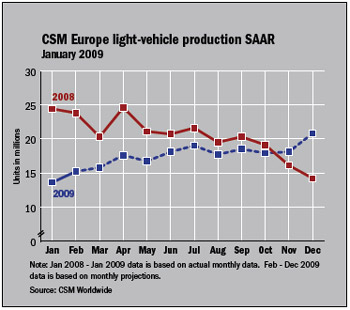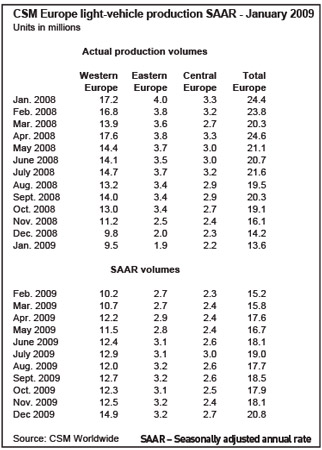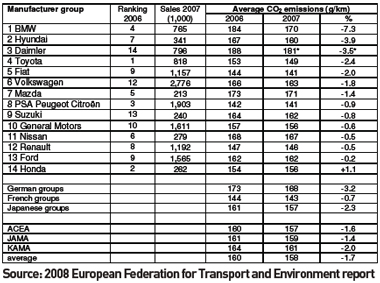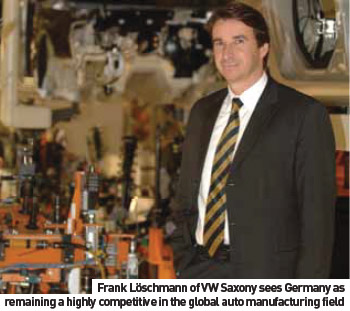
The German car industry’s workforce has been dealt a bad hand by the global downturn; jobs that were almost guaranteed for life have come under threat as carmakers frantically adjust and re-adjust their production volumes. Instead of stopping jobs from moving abroad, the priority now is maintaining jobs at home, such is the state of a market that has not seen comparable economic difficulties since the end of World War II.
Factor in tax breaks and scrappage incentives, where new car buyers trading in ten-year old (or more) cars can receive a government-funded EUR2,500 towards the purchase of a new, ‘greener’ vehicle, you might expect the global automotive market to have turned a figurative corner. But the reality is that for the most part, new car sales remain depressed, down as much as 60% across the globe.
That said, tax reforms and scrappage schemes have triggered demand in Germany. Orders for passenger cars, which had already increased by 16% by the end of January this year, grew by a further 63% in February.
Numbers fall but strengths emerge
 After six successive years of record figures, 2008 saw German manufacturer export volumes fall by 4% to 4.13 million passenger cars, while worldwide auto sales dropped by 5%. Mathias Wissmann, President of the German automobile industry association Verband der Automobilindustrie (VDA) commented: “The continuing strength of German brands is revealed by the fact that they were able to push up their market shares in strategically important markets, even under the most difficult conditions.” For example, German manufacturers gained 0.7% in Western Europe, further managing to chalk up a 1% gain in the beleaguered US market. As a whole, German manufacturers posted a 1.5% increase in Russia, while also slightly increasing their collective market share in China.
After six successive years of record figures, 2008 saw German manufacturer export volumes fall by 4% to 4.13 million passenger cars, while worldwide auto sales dropped by 5%. Mathias Wissmann, President of the German automobile industry association Verband der Automobilindustrie (VDA) commented: “The continuing strength of German brands is revealed by the fact that they were able to push up their market shares in strategically important markets, even under the most difficult conditions.” For example, German manufacturers gained 0.7% in Western Europe, further managing to chalk up a 1% gain in the beleaguered US market. As a whole, German manufacturers posted a 1.5% increase in Russia, while also slightly increasing their collective market share in China.
February exports for German manufacturers fell by 51%, to 202,000 units. Passenger car production, which had already dropped by 34% in January, was reduced by a further 47%, with many firms choosing to implement short-time working.
Yet despite the crisis, Wissmann remains optimistic: “German manufacturers will use innovative products to create the foundation for emerging from the crisis in a stronger position than our competitors.”
 These include alternative powertrains, both electric and hybrid vehicles. However, said Wissmann, enjoying the anticipation of new powertrain technologies should not cloud one’s view of reality: “Over the next ten years, the internal combustion engine will continue to prevail. It still has a lot of potential for optimization in the areas of reducing (fuel) consumption and transmission technology.” Wissmann adds that German brands already produce nearly 90 models that consume less than five litres of fuel per 100km.
These include alternative powertrains, both electric and hybrid vehicles. However, said Wissmann, enjoying the anticipation of new powertrain technologies should not cloud one’s view of reality: “Over the next ten years, the internal combustion engine will continue to prevail. It still has a lot of potential for optimization in the areas of reducing (fuel) consumption and transmission technology.” Wissmann adds that German brands already produce nearly 90 models that consume less than five litres of fuel per 100km.
The progress German carmakers are making in reducing CO2 emissions is clearly illustrated by the following figures: in 2007, the average CO2 value of all newly-registered passenger cars in Germany fell by 1.7%, while last year overall CO2 values were reduced by a further 2.9%. In fact, German manufacturers cut CO2 output by 3.1%, more than the figures achieved by imported vehicles. The smallest– savings were made by French carmakers (down by 0.8%) and the Japanese (down by 2.1%). In January 2009, the average CO2 output of newly-registered vehicles in Germany was 159.5g CO2/km (down by 4.7%), i.e. below the German tax bracket of 160g of CO2/km for the first time. “One sixth of newly-registered passenger cars now meets the strict Euro 5/6 standards,” Wissmann emphasises.
Looking to the future, Wissmann says: “If the economic stimulus packages that have already been set in motion in many countries, and the numerous state measures now being taken to encourage demand for automobiles, elicit the intended effects – as can be observed right now in the German market – the second half of 2009 could see an initial, gradual recovery in global sales.” However, this would require the stabilization of the financial, credit and capital markets.
 Truck and bus – how fast is the barometer falling?
Truck and bus – how fast is the barometer falling?
Heavy vehicle sales are important to manufacturing for two reasons; lower sales naturally mean lower production but truck sales, and the number of active trucks on the road, is an oft-quoted barometer of all industry activity, particularly automotive.
Registrations of new commercial vehicles in Germany recently fell 32%, confirming the continued weakness of the domestic economy. At 12,030 units, new registrations for vans were down 29% from February 2008, while sales in the heavy-duty segment over six tonnes GVW fell by 40%.
Over the last six months, the crisis has affected Tier suppliers even harder than the manufacturers. Since November 2008, 31 companies have had to apply for insolvency in the German-speaking regions of Europe.
Yet at the beginning of the crisis, suppliers were in a strong position. In 2007, they recorded an EBIT (Earnings Before Interest & Tax) of 6%, according to a survey by the VDA.
In 2008, despite the slump in the autumn of that year, supplier turnover still grew by 2.9%, finishing the year with a positive EBIT margin of 4.3%. But the first quarter of 2009 revealed the full effect of the crisis. Turnover collapsed by 35%, with almost all companies posting losses.
Across the board workers had to be cut, with short-time working introduced in 70% of companies. Of the 7.4 million jobs in the automotive supplier industry worldwide, 15% could still be axed by the end of 2009, though mostly outside Germany. Less than 5% of these companies are expected to post a profit, with losses over the whole industry likely to equal about 3% of turnover. Figures are not forecast (by the VDA) to return to 2007 levels until 2014 at the earliest.
BMW – quiet confidence behind cost cuts
“The market for premium vehicles will continue to grow over the medium to long term,” Norbert Reithofer, Chairman of the Board of Management of BMW AG, said at the company’s annual general meeting recently.
This may not come as much consolation or reassurance to the shrinking workforce at BMW, with employee numbers falling in the first quarter of 2009. The first three months saw 929 employees (approximately 300 of which had signed voluntary severance contracts in the previous year) leave the company. Positions opening due to staff attrition were not filled. Comprising 106,887 employees in first-quarter 2008, BMW Group’s worldwide staff total had shrunk to 99,112 by March 31, 2009, representing a 7.3% decrease.
In comparison with December 31, 2008, the number of employees had dropped by 0.9%.
Mercedes-Benz – sharing the pain
Mercedes is working hard to cut costs and rationalize production capacity – but the main area it can make cuts at present is in labour. Management and the Employee Council of Daimler AG have agreed on a package of measures to reduce labour costs, while still safeguarding employment.
 The key points of the agreement are a collective reduction in working time for employees who are not included in short time working arrangements, a reduction in the allowance paid for short-time compensation and the postponement by five months of an upcoming wage increase.
The key points of the agreement are a collective reduction in working time for employees who are not included in short time working arrangements, a reduction in the allowance paid for short-time compensation and the postponement by five months of an upcoming wage increase.
As a result of these and other measures, including actions to reduce costs and to avoid increased expenditure, Daimler AG labour costs will be reduced by EUR2 billion. A company spokesperson would not elaborate on exactly where the measures to ‘reduce costs and expenditure’ would be taken, but it is not without precedent to suggest that suppliers will feel some pain from aggressive cost-cutting and target pricing, with some ‘customer-invisible’ features possibly being removed from vehicles. This follows on from 2006, when the company boasted of removing several thousand ‘invisible’ electronic functions from its range of cars.
AMS talked to Dr. Frank Löschmann, CEO of Volkswagen Sachsen (Saxony), to get the manufacturing chief ’s take on making cars in Germany today. First AMS asked, with the balance of car making having moved East and the Euro being so strong, is making cars in the Eurozone still a good value proposition?
Frank Löschmann: Automobile manufacturing in Europe has a strong and impressive history and I think its future is also very positive. The increasing commitment of European OEMs in Eastern Europe and Asia has a lot to do with the market-specific requirements for automobiles, local sourcing of material supplies, as well as the workforce. In my opinion, automobile manufacturing in Eurozone is quite competitive, particularly with regard to European markets. Due to the poor assessability of the development of costs and, in the long run, of taxes, tariffs and increasing transport costs, on-the-spot manufacturing will become more and more important. Volkswagen is a good example of that.
AMS - There is still some difference between pay levels for all staff between the former East and West Germany. How has this difference shifted over the years?
FL - In principle, albeit in a much weaker form now, there are still differences between east and west. Productivity and know-how form the basis for a long-term approximation.
Wage differences in Eastern Germany represent an important location advantage which must be complemented with future advances in productivity and technology.
AMS - In the past you have had an excellent skill level in your workforce in eastern Germany. Has this changed? Have the skilled workers gone west or to other regions?
FL - At Volkswagen, we do everything we can to not only maintain our workforce’s high level of qualification, but also to specifically develop it further. For that reason we have established our own educational institute and have entered into cooperation agreements with various local colleges and universities. Due to the attractiveness of jobs at Volkswagen, labour piracy of qualified employees plays a minor part in our business.
AMS - Logistics and transportation have improved enormously in all of Germany over the years. How has this affected your operations in Sachsen?
FL - Volkswagen Sachsen was one of the first companies in Germany that implemented and executed just-in-time or just-in-sequence systems, as early as 1992. These principles, which we have continuously developed further since, are still central to our manufacturing systems.
AMS -We last spoke in 2006, when you were excited by laser welding, laser inline measurement and some other new technologies. What is your view now of these (admittedly expensive) processes?
FL - Laser technologies and non-destructive testing methods are technologies of the future and an inherent part of our manufacturing processes already today. In this context, Volkswagen has been a pioneer in automobile manufacturing. The initially widespread application of laser joining technologies has been optimized in the meantime and is now specifically used in those areas where verifiable quality and cost advantages exist. I am convinced that this technology’s worldwide triumph is actually still to come. From my point of view, non-destructive testing is indeed a technologically sophisticated process, but by avoiding scrapping costs it is also highly economical. And now we have personnel qualified in these processes at all of our production sites.
AMS -Volkswagen has led the way in hot stamping in the past. What is your view of this now?
FL - This is still true today. The ever-increasing requirements of passive safety and car body strength, as well as lightweight construction and hybridization in car body manufacturing, demand the use of ever-stronger components and sub-assemblies accompanied by material substitutions, etc. The amount of thermoformed components is increasing in this connection.
AMS - VW Sachsen has done a fantastic job in the making of bodies for Bentley; do you see other special VW Group products coming your way?
FL - It is the expertise of our employees in the body construction, as well as the D-class paint shop for the Phaeton and the Bentley, that performs very well within the Volkswagen Group. We see our opportunities mainly in the manufacture of future generations of today’s model range, but we are also open to new challenges.
AMS - In which production areas will you be making investments in VW Sachsen over the next year or so?
FL - In vehicle construction, this will be especially in the press shop, the body shop and the final assembly. Flexibility and modular assembly systems of the future within the Volkswagen production system will be in the foreground here. In engine production we will focus particularly on modern TSI technologies and modern alternative drive train concepts.
AMS - You have tried to reduce the working week at VW Sachsen in the past. How has this worked out now with the reduction in demand?
FL - A reduction of the weekly working time has never been a real issue at Volkswagen Sachsen. According to our labour agreement, the standard work week is 38 hours and we aim to use our plant and equipment for approximately 40 hours in a three-shift system. By means of flexible working time accounts, however, we are able to react to market fluctuations. With the exception of the new Golf, which is in great demand, we have currently taken advantage of this flexibility with the Passat and the D-class and complemented it with short-time work arrangements.
AMS - If you had a ‘dream budget’ – an unlimited amount of money to spend in one area of production – where would it be spent?
FL - The automobiles of the future are not manufactured in only one area. Powertrain and car body are developing just as dynamically as electronics and manufacturing technologies. Engine and body construction are the areas that depend most on technology and would therefore receive the lion’s share of the investments, which would also be aimed at energy efficiency, electrification and hybridization.



































